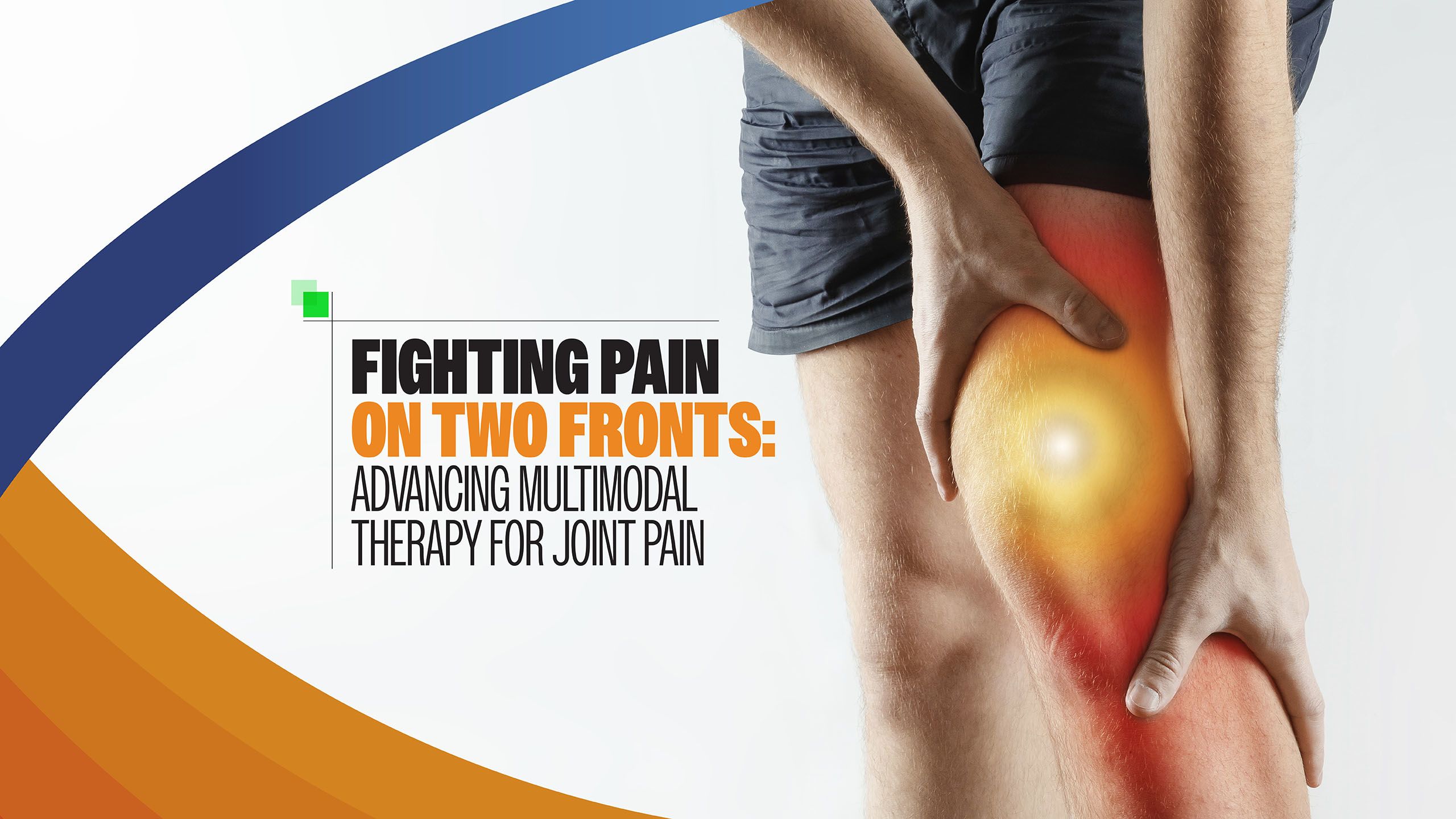
Joint pain often requires a multifaceted approach due to its complex nature, which includes both persistent discomfort and episodes of acute flare-ups.1 Pharmacists are in a key position to guide patients toward effective treatment options that leverage multimodal therapy. The combination of topical diclofenac (TDIC) and acetaminophen (APAP) addresses both systemic and localised pain mechanisms, offering a safe and effective approach.2,3 This article explores the evidence underpinning this combination therapy and underscores the pharmacist’s role in its application.






UNDERSTANDING JOINT PAIN: A DUAL CHALLENGE
Managing joint pain requires addressing two distinct aspects: baseline symptoms and the acute intensities that occur during flare-ups. Multimodal therapy has emerged as an effective strategy by targeting multiple pain pathways simultaneously. Evidence highlights that relying on monotherapy alone may not fully address the complexity of joint pain, necessitating combination therapies that improve patient outcomes.1
Pharmacists are well-positioned to adopt a tailored approach by selecting therapies that balance pain relief with minimisation of adverse effects. Combination strategies, including both topical and systemic agents, provide an excellent opportunity to achieve these goals.
ACETAMINOPHEN: A CORNERSTONE OF SYSTEMIC PAIN RELIEF
Acetaminophen (APAP) remains one of the most commonly recommended medications for joint pain due to its effectiveness and safety profile. It works centrally to modulate pain signals and is particularly useful in managing mild to moderate joint discomfort. APAP’s low risk of gastrointestinal (GI) side effects compared to oral NSAIDs makes it a preferred choice for many patients.4
The sustained-release formulations of APAP have demonstrated prolonged pain relief, which is beneficial for chronic pain management.5 Additionally, fast-dissolving APAP formulations offer rapid onset of action, which is essential for controlling acute pain flare-ups effectively.6
TOPICAL DICLOFENAC: LOCALISED PAIN MANAGEMENT WITH REDUCED SYSTEMIC RISK
Topical diclofenac (TDIC) plays a critical role in managing joint pain by delivering anti-inflammatory effects directly to the affected site. This localised action significantly reduces systemic exposure and the associated risks but still provides substantial pain and swelling relief. Studies confirm that patients who adhered to twice-daily application protocols experienced pronounced reductions in localised inflammation and discomfort.7
TDIC has also been shown to improve mobility and functionality, particularly in joints affected by persistent pain.8 Importantly, this localised option is often preferred for patients prone to systemic side effects or who cannot tolerate oral NSAIDs.9
COMBINING TDIC AND APAP: A MULTIMODAL SYNERGY
A multimodal approach combining TDIC and APAP merges their respective strengths – relief from APAP and targeted topical action from TDIC. APAP addresses central pain pathways, while TDIC directly modulates localised inflammation at the site of pain. Clinical evidence supports the efficacy of this combination in delivering superior pain control with fewer adverse effects compared to monotherapy.2,3
Combination therapy ensures that both dimensions of joint pain (chronic and acute) are addressed simultaneously. This synergy aligns with best practices in pain management, which emphasise personalised care and safety.10
EMPOWERING PHARMACISTS IN PAIN MANAGEMENT
Pharmacists are pivotal in promoting the safe and effective use of multimodal therapies for joint pain. They have key responsibilities, including:
- Dosing consultations: Educating patients on the safe upper limits of APAP to avoid risks like hepatotoxicity.
- Application guidance: Demonstrating the proper use of TDIC to maximise its localised therapeutic effects.
- Monitoring: Vigilantly assessing for adverse effects such as skin irritation or misuse of systemic analgesics.
By personalising recommendations and educating patients, pharmacists ensure that multimodal approaches optimise outcomes. They are also well-equipped to reinforce adherence to therapy regimens, essential for achieving sustained benefits in pain management.
CONCLUSION
Fighting joint pain demands a comprehensive, patient-centred approach. The combination of topical diclofenac and acetaminophen offers an evidence-based, multimodal strategy to address both localised and systemic aspects of pain.2 Armed with clinical data, pharmacists can guide patients toward therapies that maximise relief while minimising risk. By integrating these strategies into everyday practice, pharmacists can significantly improve patient mobility, comfort, and overall quality of life.
REFERENCES
- Sethi V, Anand C, Pasqua OD. Clinical assessment of osteoarthritis pain: contemporary scenario, challenges, and future perspectives. Pain Ther. 2024. Available from: https://pmc.ncbi.nlm.nih.gov/articles/PMC11111648/.
- Yue Y, Collaku A, Brown J, et al. Efficacy and speed of onset of pain relief of fast-dissolving paracetamol on postsurgical dental pain: two randomized, single-dose, double-blind, placebo-controlled clinical studies. Clin Ther. 2013. Available from: https://pubmed.ncbi.nlm.nih.gov/23972577/.
- Baraf HSB, Gloth FM, Barthel HR, et al. Safety and efficacy of topical diclofenac sodium gel for knee osteoarthritis in elderly and younger patients: pooled data from three randomized, double-blind, parallel-group, placebo-controlled, multicentre trials. Drugs Aging. 2011. Available from: https://pubmed.ncbi.nlm.nih.gov/21174485/
- Graham GG, Scott KF, Day R. Tolerability of paracetamol. PubMed. 2005. Available from: https://www.researchgate.net/publication/8000866_Tolerability_of_Paracetamolarrow_outward.
- Bacon TH, Hole JG, North M, et al. Analgesic efficacy of sustained release paracetamol in patients with osteoarthritis of the knee. Clin Pharmacol. 2002. Available from: https://pmc.ncbi.nlm.nih.gov/articles/PMC1874331/.
- Wilson CG, Clarke CP, Starkey YYL, et al. Comparison of a novel fast-dissolving acetaminophen tablet formulation (FD-APAP) and standard acetaminophen tablets using gamma scintigraphy and pharmacokinetic studies. Drug Development and Industrial Pharmacy. 2010. Available from: https://www.tandfonline.com/doi/10.3109/03639045.2010.538058?url_ver=Z39.88-2003.
- Voltaren Emulgel 12-hour [package insert]. 2022. Available from: https://pi-pil-repository.sahpra.org.za/wp-content/uploads/2022/12/pi-voltarenemulgel12hour-proposedclean-30Nov22.pdfarrow_outward
- Van Dik GM, Veenhof C, Schellevis F, et al. Comorbidity, limitations in activities and pain in patients with osteoarthritis of the hip or knee. BMC Musculoskeletal Disorders. 2008. Available from: https://bmcmusculoskeletdisord.biomedcentral.com/articles/10.1186/1471-2474-9-95.
- Antman EM, Bennett JS, Daugherty A, et al. Use of nonsteroidal antiinflammatory drugs: an update for clinicians: a scientific statement from the American Heart Association. Circulation. 2007. Available from: https://www.ahajournals.org/doi/10.1161/CIRCULATIONAHA.106.181424?url_ver=Z39.88-2003&rfr_id=ori:rid:crossref.org&rfr_dat=cr_pub%20%200pubmed
- Roth SH, Fuller P. Diclofenac topical solution compared with oral diclofenac: a pooled safety analysis. J Pain Res. 2011. Available from: https://pmc.ncbi.nlm.nih.gov/articles/PMC3141832/.
Image Credit: Getty Images


